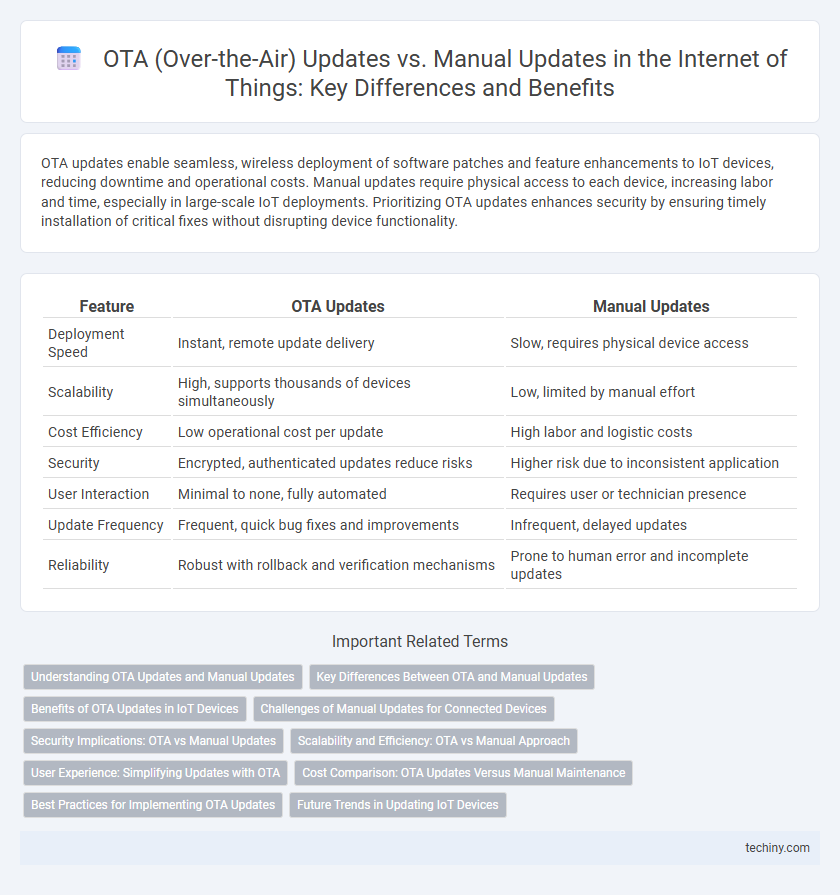OTA updates enable seamless, wireless deployment of software patches and feature enhancements to IoT devices, reducing downtime and operational costs. Manual updates require physical access to each device, increasing labor and time, especially in large-scale IoT deployments. Prioritizing OTA updates enhances security by ensuring timely installation of critical fixes without disrupting device functionality.
Table of Comparison
| Feature | OTA Updates | Manual Updates |
|---|---|---|
| Deployment Speed | Instant, remote update delivery | Slow, requires physical device access |
| Scalability | High, supports thousands of devices simultaneously | Low, limited by manual effort |
| Cost Efficiency | Low operational cost per update | High labor and logistic costs |
| Security | Encrypted, authenticated updates reduce risks | Higher risk due to inconsistent application |
| User Interaction | Minimal to none, fully automated | Requires user or technician presence |
| Update Frequency | Frequent, quick bug fixes and improvements | Infrequent, delayed updates |
| Reliability | Robust with rollback and verification mechanisms | Prone to human error and incomplete updates |
Understanding OTA Updates and Manual Updates
OTA updates enable seamless remote delivery of firmware or software improvements to Internet of Things devices, eliminating the need for physical access and minimizing downtime. Manual updates require direct user intervention, typically involving connecting devices to a computer or using external media, which can be time-consuming and prone to human error. OTA updates provide enhanced scalability and security by supporting encrypted transmissions and automated version control across distributed IoT networks.
Key Differences Between OTA and Manual Updates
OTA (Over-the-Air) updates enable remote, wireless distribution of firmware and software improvements directly to IoT devices, minimizing downtime and eliminating the need for physical access. Manual updates require on-site intervention, often involving device disassembly or connection to update tools, which increases labor costs and introduces higher risks of human error. OTA updates provide real-time, scalable, and secure delivery, whereas manual updates are slower and less efficient, particularly in large-scale IoT deployments.
Benefits of OTA Updates in IoT Devices
Over-the-air (OTA) updates in IoT devices enable seamless, remote firmware and software upgrades without physical intervention, significantly reducing downtime and maintenance costs. OTA updates enhance device security by promptly patching vulnerabilities and ensuring all devices run the latest software versions, improving overall network resilience. This automated approach supports scalability for large IoT deployments by enabling bulk updates, minimizing operational disruptions, and accelerating feature rollouts across diverse device ecosystems.
Challenges of Manual Updates for Connected Devices
Manual updates for connected devices face significant challenges including limited scalability, as each device requires physical access or user intervention, causing delays and increased labor costs. The risk of update errors and device downtime is higher without centralized control, impacting device reliability and user experience. Security vulnerabilities are harder to manage, since inconsistent update schedules and failed installations expose devices to threats over extended periods.
Security Implications: OTA vs Manual Updates
OTA updates enhance IoT security by enabling rapid deployment of patches and vulnerability fixes, reducing exposure to emerging threats compared to the slower, risk-prone manual update process. Manual updates often suffer from delayed implementation and human error, increasing the likelihood of prolonged security gaps and device compromise. Automated OTA mechanisms also support encryption and authentication protocols, ensuring data integrity and secure delivery, which manual methods typically lack.
Scalability and Efficiency: OTA vs Manual Approach
OTA updates enable scalable deployment across millions of IoT devices by allowing remote, simultaneous software upgrades without physical intervention, significantly reducing downtime and operational costs. Manual updates demand individual device access, leading to increased labor, higher error rates, and limited scalability as device networks grow. Prioritizing OTA solutions enhances efficiency through automated processes, real-time monitoring, and rapid error correction, making them ideal for expansive IoT ecosystems.
User Experience: Simplifying Updates with OTA
OTA (Over-the-air) updates enhance user experience by enabling seamless, automatic installation of software improvements without manual intervention, reducing downtime and technical barriers. Unlike manual updates that require user initiation and can involve complex steps, OTA updates deliver real-time patches and feature enhancements directly to IoT devices, ensuring up-to-date performance and security. This streamlined process not only increases user convenience but also supports consistent device functionality and scalability across diverse IoT ecosystems.
Cost Comparison: OTA Updates Versus Manual Maintenance
OTA updates significantly reduce maintenance costs by eliminating the need for physical device access and on-site technician visits, resulting in lower labor and transportation expenses. Manual updates incur higher operational costs due to the necessity of direct interaction with each device, increased downtime, and the risk of human error during installation. Cost efficiency of OTA solutions scales with the number of devices and frequency of updates, proving more economical for large IoT deployments compared to manual maintenance.
Best Practices for Implementing OTA Updates
Implementing OTA (Over-the-Air) updates in IoT devices requires ensuring secure data transmission through end-to-end encryption and validating firmware integrity with cryptographic signatures to prevent tampering. Best practices include designing fail-safe mechanisms such as automatic rollback to previous stable versions in case of update failures, along with thorough testing in simulated environments to avoid performance degradation or device bricking. Efficient update scheduling and bandwidth optimization reduce network congestion, while maintaining detailed logging and user alerts enhances transparency and troubleshooting capabilities.
Future Trends in Updating IoT Devices
Over-the-air (OTA) updates are rapidly becoming the preferred method for maintaining IoT devices due to their scalability, reduced downtime, and enhanced security features, enabling seamless deployment of firmware improvements across distributed networks. Manual updates, while offering direct control, are increasingly seen as impractical for large-scale IoT ecosystems because they require physical access and can lead to inconsistent device performance. Emerging trends point towards AI-driven predictive updates and blockchain-based verification to further streamline OTA processes, ensuring real-time adaptability and robust protection against cyber threats in future IoT environments.
OTA (Over-the-air) updates vs Manual updates Infographic

 techiny.com
techiny.com